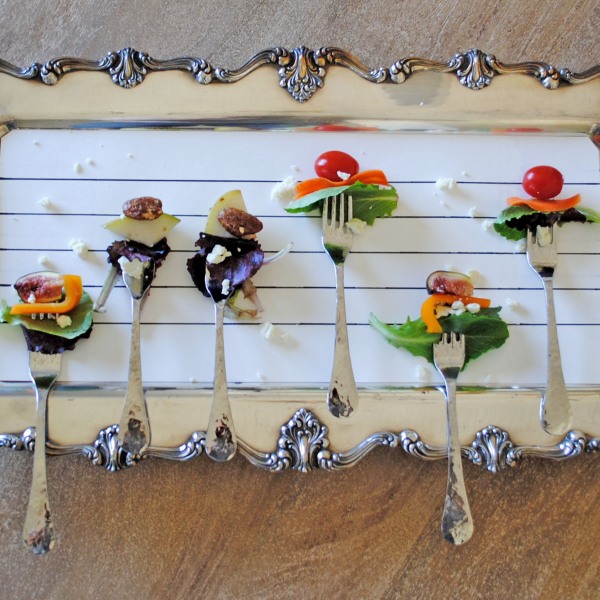Music comes to our ears from composers as a sequence of tones through instruments. Same could be said for the culinary arts. The artist of the kitchen delivers into conceptual reality a song as surely as the poet whispers a world into existence through words.
Assuming that you are such a kitchen artist, how might the venerable salad act as a means of communication? First thing to realize is how dynamic this course has become. The modern salad often appears as bouquet of vegetables. In contrast, steak or a side of potatoes is simple like a bongo drum. Low tones and leathery high tones. Rich and satisfying. Primal and mysterious. Yes! But a salad is the pixie that dances around the campsite darting in and out of shadows. It carries the unique ability to randomly form flavors with each forkful. Let’s consider this further.
If we take the concept of music as a collection of certain sounds artfully arranged over time, then salad is a collection of bites randomly arranged over time. The composer plays with a pallete of notes, arranged into melodies underwritten by a musical theme. The cook who tosses fruits, vegetables, proteins, and the like also works within a fixed pallete. They find sympathetic and contrasting notes to add life to the dish. Sometimes this presents a variety of color, shapes, textures to the eyes. And we eat first with our eyes.
What’s amazing in this dish is the infinite combinations. Almost like a jam session with jazz musicians. The drums beat. The bassist defines the theme and the other instruments dance on top providing intrigue through on-the-spot creation. A new vocabulary invented for just that moment. Just that mood. Savoring a salad is remarkably similar. The salad greens act as the drum beat providing crunch or cushion. Most leaves impart their own herbal flavor tones as well. Yes, let’s not forget that while we beat rhythm with greens, they do have their own voices.
Next the cook brings the salad together through the dressing. It may be a simple squeeze of lemon juice for our skinny-minded diners, or it could be the operatic beauty of ceaser salad dressing. The fat lady not only sings but the flight of the valkeries rumbles overhead. The dressing hums the base line ensuring continuity that this salad is this particular salad. It harmonizes with the other ingredients often exposing their brightness through contrast. Want to really embrace the sweet of strawberries? Wrap it in balsamic with the tender sourness that comes from this raisin-like vinegar.
Carrot ribbons, sliced pears, candied pecans, tomatoes, figs, Holland peppers and crumbly cotija cheese are the chords. Their combination forms the melodies. Here the cook teases our palette with the fresh and the familiar. Maybe an intriguing combination of ham and pear. The addition of cheese or nuts to round out mouth feel. They can amuse the tartness of a vinaigrette like the giggle of the Pillsbury Doughboy. Regardless, the cook paints with her fine brush with these additions. Their gift is what changes the mess of colors into an inviting landscape.
What lifts salad into a whole new category is not just the random combinations or the vibrant assembly of ingredients. It’s the diner. At most concert halls, the audience drinks in the music through their ears with the an occasional stare at the orchestra or people around them. With a main course of salad, the eater chooses the sequencing. They actively make choices what gets translated into their conceptual reality. They play the instruments in the jam session. Some will admit to stabbing the tines deep into the bowl for whatever comes up. Others carefully select the combos for just. The. Perfect. Bite. My Hunney does this. And why not?
Now imagine a world where the chef prepares the salad bite by bite. Like a traditional composer, arranging high notes and low notes in perfect sequence. Your plate would stretch East to West like a musical score. Many forkfuls later, the song would end. Wouldn’t that be a remarkable event? To dive even deeper to the world of the kitchen artist. To experience more fully the thought process. To dive into his or her personal narrative. To soak in their story and wrap tight the blanket of conceptual reality. To connect with their inner vision. Wow. What would Lewis Carol say to that?


Pingback: Some assembly required | ideas that taste good